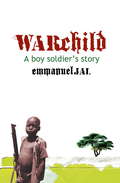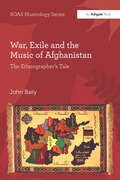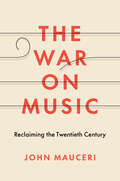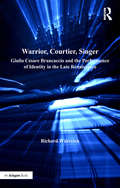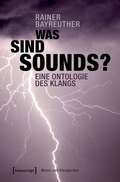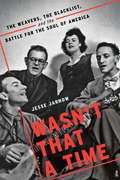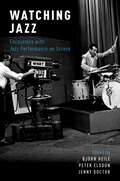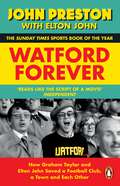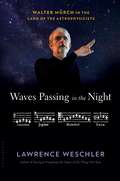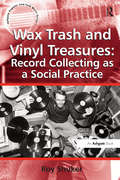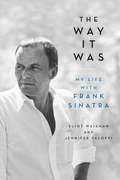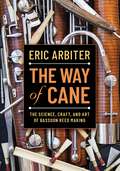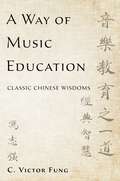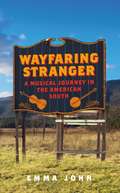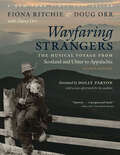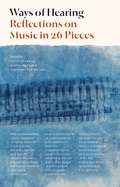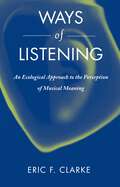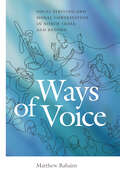- Table View
- List View
War Child: A Boy Soldier's Story
by Emmanuel JalEmmanuel Jal was only seven years old when he was taken from his family home to become a child soldier with the rebel army in Sudan's bloody civil war for nearly five years. Beaten, starved and brutalised Emmanuel was put into battle in Ethiopia and southern Sudan carrying an AK-47 talller than himself.He attempted to leave the SPLA but was hunted down and thrown into a desert prison. He finally escaped and is now an internationally-acclaimed rap artist spreading messages of peace and reconciliation with his unique style of gospel rap.
War, Exile and the Music of Afghanistan: The Ethnographer’s Tale (SOAS Studies in Music)
by John BailyIn the 1970s John Baily conducted extensive ethnomusicological research in Afghanistan, principally in the city of Herat but also in Kabul. Then, with Taraki’s coup in 1978, came conflict, war, and the dispersal of many musicians to locations far and wide. This new publication is the culmination of Baily’s further research on Afghan music over the 35 years that followed. This took him to Afghanistan, Pakistan, Iran, the USA, Australia and parts of Europe - London, Hamburg and Dublin. Arranged chronologically, the narrative traces the sequence of political events - from 1978, through the Soviet invasion, to the coming of the Taliban and, finally, the aftermath of the US-led invasion in 2001. He examines the effects of the ever-changing situation on the lives and works of Afghan musicians, following individual musicians in fascinating detail. At the heart of his analysis are privileged vignettes of ten musical personalities - some of friends, and some newly discovered. The result is a remarkable personal memoir by an eminent ethnomusicologist known for his deep commitment to Afghanistan, Afghan musicians and Afghan musical culture. John Baily is also an ethnographic filmmaker. Four of his films relating to his research are included on the downloadable resources that accompanies the text.
War, Exile and the Music of Afghanistan: The Ethnographer’s Tale (SOAS Studies in Music)
by John BailyIn the 1970s John Baily conducted extensive ethnomusicological research in Afghanistan, principally in the city of Herat but also in Kabul. Then, with Taraki’s coup in 1978, came conflict, war, and the dispersal of many musicians to locations far and wide. This new publication is the culmination of Baily’s further research on Afghan music over the 35 years that followed. This took him to Afghanistan, Pakistan, Iran, the USA, Australia and parts of Europe - London, Hamburg and Dublin. Arranged chronologically, the narrative traces the sequence of political events - from 1978, through the Soviet invasion, to the coming of the Taliban and, finally, the aftermath of the US-led invasion in 2001. He examines the effects of the ever-changing situation on the lives and works of Afghan musicians, following individual musicians in fascinating detail. At the heart of his analysis are privileged vignettes of ten musical personalities - some of friends, and some newly discovered. The result is a remarkable personal memoir by an eminent ethnomusicologist known for his deep commitment to Afghanistan, Afghan musicians and Afghan musical culture. John Baily is also an ethnographic filmmaker. Four of his films relating to his research are included on the downloadable resources that accompanies the text.
The War on Music: Reclaiming the Twentieth Century
by John MauceriA prominent conductor explores how aesthetic criteria masked the political goals of countries during the three great wars of the past century This book offers a major reassessment of classical music in the twentieth century. John Mauceri argues that the history of music during this span was shaped by three major wars of that century: World War I, World War II, and the Cold War. Probing why so few works have been added to the canon since 1930, Mauceri examines the trajectories of great composers who, following World War I, created voices that were unique and versatile, but superficially simpler. He contends that the fate of composers during World War II is inextricably linked to the political goals of their respective governments, resulting in the silencing of experimental music in Germany, Italy, and Russia; the exodus of composers to America; and the sudden return of experimental music—what he calls “the institutional avant-garde”—as the lingua franca of classical music in the West during the Cold War.
Warrior, Courtier, Singer: Giulio Cesare Brancaccio and the Performance of Identity in the Late Renaissance
by Richard WistreichGiulio Cesare Brancaccio was a Neapolitan nobleman with long practical experience of military life, first in the service of Charles V and later as both soldier and courtier in France and then at the court of Alfonso II d'Este at Ferrara. He was also a virtuoso bass singer whose performances were praised by both Tasso and Guarini - he was even for a while the only male member of the famous Ferrarese court Concerto delle dame, who established a legendary reputation during the 1580s. Richard Wistreich examines Brancaccio's life in detail and from this it becomes possible to consider the mental and social world of a warrior and courtier with musical skills in a broader context. A wide-ranging study of bass singing in sixteenth- and early seventeenth-century Italy provides a contextual basis from which to consider Brancaccio's reputation as a performer. Wistreich illustrates the use of music in the process of 'self-fashioning' and the role of performance of all kinds in the construction of male noble identity within court culture, including the nature and currency of honour, chivalric virtù and sixteenth-century notions of gender and virility in relation to musical performance. This fascinating examination of Brancaccio's social world significantly expands our understanding of noble culture in both France and Italy during the sixteenth century, and the place of music-making within it.
Warrior, Courtier, Singer: Giulio Cesare Brancaccio and the Performance of Identity in the Late Renaissance
by Richard WistreichGiulio Cesare Brancaccio was a Neapolitan nobleman with long practical experience of military life, first in the service of Charles V and later as both soldier and courtier in France and then at the court of Alfonso II d'Este at Ferrara. He was also a virtuoso bass singer whose performances were praised by both Tasso and Guarini - he was even for a while the only male member of the famous Ferrarese court Concerto delle dame, who established a legendary reputation during the 1580s. Richard Wistreich examines Brancaccio's life in detail and from this it becomes possible to consider the mental and social world of a warrior and courtier with musical skills in a broader context. A wide-ranging study of bass singing in sixteenth- and early seventeenth-century Italy provides a contextual basis from which to consider Brancaccio's reputation as a performer. Wistreich illustrates the use of music in the process of 'self-fashioning' and the role of performance of all kinds in the construction of male noble identity within court culture, including the nature and currency of honour, chivalric virtù and sixteenth-century notions of gender and virility in relation to musical performance. This fascinating examination of Brancaccio's social world significantly expands our understanding of noble culture in both France and Italy during the sixteenth century, and the place of music-making within it.
Warum Musik in unseren Genen liegt
by Jörn Bullerdiek Christine SüßmuthWussten Sie, warum Johann Sebastian Bach ganz legal lange Finger machte? Und was Sie alles mit einer Haarlocke Mozarts anfangen könnten, wenn Sie sie besäßen? Beides könnte Sie auf die Spur eines uralten Geheimnisses bringen, nämlich warum Menschen Freude am „Hervorbringen musikalischer Töne“ haben, wie Darwin es formulierte. Liegt das wortwörtlich in unserer DNA und was hat es dort zu suchen? Die Autoren sind in gefährlicher Nähe am Felsen der Sirenen vorbei gesegelt und haben Orpheus in die Unterwelt begleitet. Sie haben den Weg von Schallwellen von ihrer Quelle bis zum Gehirn der Hörenden verfolgt und ebenso den Stammbaum der Familie Bach wie den Gesang von Zebrafinken analysiert. Schließlich sind sie nicht nur in den Sonderzug nach Pankow gestiegen, sondern haben auch noch die Caprifischer in ihrer Heimat aufgesucht. Alles in allem ist eine unterhaltsame und informative Analyse dessen entstanden, was vom alten Ägypten bis in heutige Zeit die Faszination von Musik im Spiegel unserer Gene ausmacht.
Was sind Sounds?: Eine Ontologie des Klangs (Musik und Klangkultur #36)
by Rainer BayreutherWas sichtbare oder tastbare Dinge sind, weiß jede_r. Was aber sind hörbare Dinge? Die Klangquelle, die Luftschwingung oder die Klänge selber? Und welche Eigenschaften haben diese Dinge? In diesem Grundlagenwerk für Sound Studies und Musikwissenschaft, für das Kartographieren von Geräuschen sowie für Klangfetischisten, entwickelt Rainer Bayreuther in einer klaren ontologischen Systematik die Individualität sowie die Eigenschaften von Klängen. Die Arbeit wird anhand zahlreicher Fallbeispiele veranschaulicht.
Wasn't That a Time: The Weavers, the Blacklist, and the Battle for the Soul of America
by Jesse JarnowThe dramatic untold story of the Weavers, the hit-making folk-pop quartet destroyed with the aid of the United States government -- and who changed the world, anyway Following a series of top-ten hits that became instant American standards, the Weavers dissolved at the height of their fame. Wasn't That a Time: The Weavers, the Blacklist, and the Battle for the Soul of America details the remarkable rise of Pete Seeger's unlikely band of folk heroes, from basement hootenannies to the top of the charts, and the harassment campaign that brought them down. Exploring how a pop group's harmonies might be heard as a threat worthy of decades of investigation by the FBI, Wasn't That a Time turns the black-and-white 1950s into vivid color, using the Weavers to illuminate a dark and complex period of American history. With origins in the radical folk collective the Almanac Singers and the ambitious People's Songs, the singing activists in the Weavers set out to change the world with songs as their weapons, pioneering the use of music as a transformative political organizing tool. Using previously unseen journals and letters, unreleased recordings, once-secret government documents, and other archival research, Jesse Jarnow uncovers the immense hopes, incredible pressures, and daily struggles of the four distinct and often unharmonious personalities at the heart of the Weavers. In an era defined by a sharp political divide that feels all too familiar, the Weavers became heroes. With a class -- and race -- conscious global vision that now makes them seem like time travelers from the twenty-first century, the Weavers became a direct influence on a generation of musicians and listeners, teaching the power of eclectic songs and joyous, participatory harmonies.
Watching Jazz: Encounters with Jazz Performance on Screen
by Bjö Heile Peter Elsdon Jenny DoctorWatching Jazz: Encounters with Jazz Performance on Screen is the first systematic study of jazz on screen media. Where earlier studies have focused almost entirely on the role and portrayal of jazz in Hollywood film, the present book engages with a plethora of technologies and media from early film and soundies through television to recent developments in digital technologies and online media. Likewise, the authors discuss jazz in the widest sense, ranging from Duke Ellington and Jimmy Dorsey through the likes of Dizzy Gillespie, Art Blakey, Oscar Peterson, Miles Davis, John Coltrane and Charles Mingus to Pat Metheny. Much of this rich and fascinating material has never been studied in depth before, and what emerges most clearly are the manifold connections between the music and the media on which it was and is being recorded. Its long association with film and television has left its trace in jazz, just as online and social media are subtly shaping it now. Vice versa, visual media have always benefited from focusing on music and this significantly affected their development. The book follows these interrelations, showing how jazz was presented and represented on screen and what this tells us about the music, the people who made it and their audiences. The result is a new approach to jazz and the media, which will be required reading for students of both fields.
WATCHING JAZZ C: Encounters with Jazz Performance on Screen
by Björn Heile, Peter Elsdon, and Jenny DoctorWatching Jazz: Encounters with Jazz Performance on Screen is the first systematic study of jazz on screen media. Where earlier studies have focused almost entirely on the role and portrayal of jazz in Hollywood film, the present book engages with a plethora of technologies and media from early film and soundies through television to recent developments in digital technologies and online media. Likewise, the authors discuss jazz in the widest sense, ranging from Duke Ellington and Jimmy Dorsey through the likes of Dizzy Gillespie, Art Blakey, Oscar Peterson, Miles Davis, John Coltrane and Charles Mingus to Pat Metheny. Much of this rich and fascinating material has never been studied in depth before, and what emerges most clearly are the manifold connections between the music and the media on which it was and is being recorded. Its long association with film and television has left its trace in jazz, just as online and social media are subtly shaping it now. Vice versa, visual media have always benefited from focusing on music and this significantly affected their development. The book follows these interrelations, showing how jazz was presented and represented on screen and what this tells us about the music, the people who made it and their audiences. The result is a new approach to jazz and the media, which will be required reading for students of both fields.
Watford Forever: How Graham Taylor and Elton John Saved a Football Club, a Town and Each Other
by John Preston Elton JohnThe Sunday Times Sports Book of the YearA Times Book of the YearA Financial Times Book of the YearA Guardian Book of the YearA New Statesman Book of the Year'The heartwarming story of the collaboration and friendship between English football’s oddest couple, Elton John and Graham Taylor' The Times' A wonderful, feel-good account of an ultimately English provincial story' Simon Kuper_____________________ An unforgettable British underdog story from one of our greatest narrative nonfiction writers, John Preston, and the international musical icon and bestselling author, Sir Elton John.Britain in the 1970s was beset by unrest and unemployment, as inflation soared, fuel was scarce, and hooliganism was on the rise. And for Watford FC, the outlook was even gloomier. Rundown and rat-infested, Watford were an ailing side with holes in their kit and barely enough fans to fill a stand. Of the 92 clubs in the Football League, spread across four divisions, Watford were in 92nd place.Meanwhile, Elton John was the most successful rockstar in the world. With six-inch platforms, spangled jumpsuits, and peroxide hair, he was glamorous, gay, and seemingly a world away from the semi-detached house in Pinner where he had supported Watford FC as a child. Many assumed he would move to America. Instead, he bought the football club.Watford Forever is the remarkable story of Elton John's ownership of Watford FC and its transformational journey to the top of the First Division under iconic manager Graham Taylor. Perhaps most remarkably, four of the same players who had been written off as has-beens went with them all the way from the bottom to the top. Inspiring and infectiously funny, this is a tribute to football's unlikeliest friendship as Elton John and Taylor, a straight-talking former fullback with a love of Vera Lynn, beat the odds and their personal demons to save a club and a community.Immersed in the grime and glamour of '70s Britain, Watford Forever is one of sport's great underdog stories and a love letter to the beautiful game.
Waves Passing in the Night: Walter Murch in the Land of the Astrophysicists
by Lawrence WeschlerFrom Pulitzer Prize nominee Lawrence Weschler, a fascinating profile of Walter Murch, a film legend and amateur astrophysicist whose investigations could reshape our understanding of the universe.For film aficionados, Walter Murch is legendary--a three-time Academy Award winner, arguably the most admired sound and film editor in the world for his work on Apocalypse Now, The Godfather trilogy, The English Patient, and many others. Outside of the studio, his mind is wide-ranging; his passion, pursued for several decades, has been astrophysics, in particular the rehabilitation of Titius-Bode, a long-discredited 18th century theory regarding the patterns by which planets and moons array themselves in gravitational systems across the universe. Though as a consummate outsider he's had a hard time attracting any sort of comprehensive hearing from professional astrophysicists, Murch has made advances that even some of them find intriguing, including a connection between Titius Bode and earlier notions--going back past Kepler and Pythagorus--of musical harmony in the heavens. Unfazed by rejection, ever probing, Murch perseveres in the highest traditions of outsider science.Lawrence Weschler brings Murch's quest alive in all its seemingly quixotic, yet still plausible, splendor, probing the basis for how we know what we know, and who gets to say. "The wholesale rejection of alternative theories has repeatedly held back the progress of vital science," Weschler observes, citing early twentieth-century German amateur Alfred Wegener, whose speculations about continental drift were ridiculed at first, only to be accepted as fact decades later. Theoretical physicist Lee Smolin says "It is controversy that brings science alive"--and Murch's quest does that in spades. His fascination with the way the planets and their moons are arranged opens up the field of celestial mechanics for general readers, sparking an awareness of the vast and (to us) invisible forces constantly at play in the universe.
Wax Trash and Vinyl Treasures: Record Collecting As A Social Practice (Ashgate Popular And Folk Music Ser.)
by Roy ShukerThe term 'record collecting' is shorthand for a variety of related practices. Foremost is the collection of sound recordings in various formats - although often with a marked preference for vinyl - by individuals, and it is this dimension of record collecting that is the focus of this book. Record collecting, and the public stereotypes associated with it, is frequently linked primarily with rock and pop music. Roy Shuker focuses on these broad styles, but also includes other genres and their collectors, notably jazz, blues, exotica and 'ethnic' music. Accordingly, the study examines the history of record collecting; profiles collectors and the collecting process; considers categories - especially music genres - and types of record collecting and outlines and discusses the infrastructure within which collecting operates. Shuker situates this discussion within the broader literature on collecting, along with issues of cultural consumption, social identity and 'the construction of self' in contemporary society. Record collecting is both fascinating in its own right, and provides insights into broader issues of nostalgia, consumption and material culture.
Wax Trash and Vinyl Treasures: Record Collecting as a Social Practice
by Roy ShukerThe term 'record collecting' is shorthand for a variety of related practices. Foremost is the collection of sound recordings in various formats - although often with a marked preference for vinyl - by individuals, and it is this dimension of record collecting that is the focus of this book. Record collecting, and the public stereotypes associated with it, is frequently linked primarily with rock and pop music. Roy Shuker focuses on these broad styles, but also includes other genres and their collectors, notably jazz, blues, exotica and 'ethnic' music. Accordingly, the study examines the history of record collecting; profiles collectors and the collecting process; considers categories - especially music genres - and types of record collecting and outlines and discusses the infrastructure within which collecting operates. Shuker situates this discussion within the broader literature on collecting, along with issues of cultural consumption, social identity and 'the construction of self' in contemporary society. Record collecting is both fascinating in its own right, and provides insights into broader issues of nostalgia, consumption and material culture.
The Way It Was: My Life with Frank Sinatra
by Eliot Weisman Jennifer ValoppiA candid and eye-opening inside look at the final decades of Sinatra's life told by his longtime manager and friend, Eliot Weisman.By the time Weisman met Sinatra in 1976, he was already the Voice, a man who held sway over popular music and pop culture for forty years, who had risen to the greatest heights of fame and plumbed the depths of failure, all the while surviving with the trademark swagger that women pined for and men wanted to emulate. Passionate and generous on his best days, sullen and unpredictable on his worst, Sinatra invited Weisman into his inner circle, an honor that the budding celebrity manager never took for granted. Even when he was caught up in a legal net designed to snare Sinatra, Weisman went to prison rather than being coerced into telling prosecutors what they wanted to hear. With Weisman's help, Sinatra orchestrated in his final decades some of the most memorable moments of his career. There was the Duets album, which was Sinatra's top seller, the massive tours, such as Together Again, which featured a short-lived reunion of the Rat Pack--until Dean Martin, having little interest in reliving the glory days, couldn't handle it anymore--and the Ultimate Event Tour, which brought Liza Minelli and Sammy Davis Jr. on board and refreshed the much-needed lining of both their pocketbooks. Weisman also worked with many other acts, including Steve Lawrence and Eydie Gorme, and an ungrateful Don Rickles, whom Weisman helped get out from under the mob's thumb. Over their years together, Weisman became a confidant to the man who trusted few, and he came to know Sinatra's world intimately: his wife, Barbara, who socialized with princesses and presidents and tried to close Sinatra off from his rough and tough friends such as Jilly Rizzo; Nancy Jr., who was closest to her dad; Tina, who aggressively battled for her and her siblings' rights to the Sinatra legacy and was most like her father; and Frank Jr., the child with the most fraught relationship with the legendary entertainer. Ultimately Weisman, who had become the executor of Sinatra's estate, was left alone to navigate the infighting and hatred between those born to the name and the wife who acquired it, when a mystery woman showed up and threatened to throw the family's future into jeopardy. Laden with surprising, moving, and revealing stories, The Way It Was also shows a side of Sinatra few knew. As a lion in winter, he was struggling with the challenges that come with old age, as well as memory loss, depression, and antidepressents. Weisman was by his side through it all, witness to a man who had towering confidence, staggering fearlessness, and a rarely seen vulnerability that became more apparent as his final days approached.
The Way of Cane: The Science, Craft, and Art of Bassoon Reed-making
by Eric ArbiterAs the sound-producing mechanism for the bassoon, the reed is a vital component in the sound of the entire instrument. While pre-manufactured reeds are widely available for purchase at music stores, this one-size-fits-all option hardly does justice to the unique needs of the musician and the piece. Many bassoonists, including seasoned professional bassoonist Eric Arbiter, instead choose to craft their own reeds. A nuanced and difficult craft to master, reed-making involves specialized machinery and necessitates special attention to the thickness, and even topography, of the reed itself. When done correctly, however, this process results in a reed that not only produces a more beautiful sound, but also holds up to even the most demanding musical performances. In The Way of Cane, Arbiter demystifies this process for bassoonists of all levels of experience. Drawing from his decades-long experience as both musician and reed-maker, Arbiter provides a comprehensive yet accessible overview of the craft, from the differing sound qualities produced by changing the dimensions of the reed's blades to the changes in the reed's behaviors as it passes through cycles of wetting and drying during production. Small changes in each of these variables, Arbiter explains, contribute to the ultimate goal of producing a bassoonist's ideal sound. With step-by-step instructions, detailed photos that further illuminate the reed-making process, and a companion website featuring the author's own recordings. The Way of Cane emphasizes the importance of the reed to the bassoon's sound, as well as the harmony between reed and musician.
WAY OF CANE C: The Science, Craft, and Art of Bassoon Reed-making
by Eric ArbiterAs the sound-producing mechanism for the bassoon, the reed is a vital component in the sound of the entire instrument. While pre-manufactured reeds are widely available for purchase at music stores, this one-size-fits-all option hardly does justice to the unique needs of the musician and the piece. Many bassoonists, including seasoned professional bassoonist Eric Arbiter, instead choose to craft their own reeds. A nuanced and difficult craft to master, reed-making involves specialized machinery and necessitates special attention to the thickness, and even topography, of the reed itself. When done correctly, however, this process results in a reed that not only produces a more beautiful sound, but also holds up to even the most demanding musical performances. In The Way of Cane, Arbiter demystifies this process for bassoonists of all levels of experience. Drawing from his decades-long experience as both musician and reed-maker, Arbiter provides a comprehensive yet accessible overview of the craft, from the differing sound qualities produced by changing the dimensions of the reed's blades to the changes in the reed's behaviors as it passes through cycles of wetting and drying during production. Small changes in each of these variables, Arbiter explains, contribute to the ultimate goal of producing a bassoonist's ideal sound. With step-by-step instructions, detailed photos that further illuminate the reed-making process, and a companion website featuring the author's own recordings. The Way of Cane emphasizes the importance of the reed to the bassoon's sound, as well as the harmony between reed and musician.
A Way of Music Education: Classic Chinese Wisdoms
by C. Victor FungMoving back through Dewey, Heidegger, Nietzsche, and Rousseau, the lineage of Western music education finds its origins in Plato and Pythagoras. Yet theories not rooted in the ancient Greek tradition are all but absent. A Way of Music Education provides a much-needed intervention, integrating ancient Chinese thought into the canon of music education in a structured, systematized, and philosophical way. The book's three central sources - the Yijing (The Book of Changes), Confucianism, and Daoism - inform author C. Victor Fung's argument: that the human being exists as an entity at the center of an organismic world in which all things and events, including music and music education, are connected. Fung ultimately proposes a new educational philosophy based on three key ideas in Chinese thought: change, balance, and liberation. A unique work, A Way of Music Education offers a universal approach engrained in a specific and ancient cultural tradition.
WAY OF MUSIC EDUCATION C: Classic Chinese Wisdoms
by C. Victor FungMoving back through Dewey, Heidegger, Nietzsche, and Rousseau, the lineage of Western music education finds its origins in Plato and Pythagoras. Yet theories not rooted in the ancient Greek tradition are all but absent. A Way of Music Education provides a much-needed intervention, integrating ancient Chinese thought into the canon of music education in a structured, systematized, and philosophical way. The book's three central sources - the Yijing (The Book of Changes), Confucianism, and Daoism - inform author C. Victor Fung's argument: that the human being exists as an entity at the center of an organismic world in which all things and events, including music and music education, are connected. Fung ultimately proposes a new educational philosophy based on three key ideas in Chinese thought: change, balance, and liberation. A unique work, A Way of Music Education offers a universal approach engrained in a specific and ancient cultural tradition.
Wayfaring Stranger: A Musical Journey in the American South
by Emma JohnCan you feel nostalgic for a life you've never known?Suffused with her much-loved warmth and wit, Emma John's memoir follows her moving and memorable journey to master one of the hardest musical styles on earth - and to find her place in an alien world.Emma had fallen out of love with her violin when a chance trip to the American South introduced her to bluegrass music. Classically trained, highly strung and wedded to London life, Emma was about as country as a gin martini. So why did it feel like a homecoming?Answering that question takes Emma deep into the Appalachian mountains, where she uncovers a hidden culture that confounds every expectation - and learns some emotional truths of her own.
Wayfaring Strangers: The Musical Voyage from Scotland and Ulster to Appalachia
by Fiona Ritchie Doug OrrFrom the seventeenth through the nineteenth centuries, a steady stream of Scots migrated to Ulster and eventually onward across the Atlantic to resettle in the United States. Many of these Scots-Irish immigrants made their way into the mountains of the southern Appalachian region. They brought with them a wealth of traditional ballads and tunes from the British Isles and Ireland, a carrying stream that merged with sounds and songs of English, German, Welsh, African American, French, and Cherokee origin. Their enduring legacy of music flows today from Appalachia back to Ireland and Scotland and around the globe. Ritchie and Orr guide readers on a musical voyage across oceans, linking people and songs through centuries of adaptation and change.Enriched by the insights of key contributors to the living tradition on both sides of the Atlantic, accompanying this abundantly illustrated volume is an online Spotify playlist featuring over 20 songs by musicians profiled in the book, including Dolly Parton, Dougie MacLean, Cara Dillon, John Doyle, Pete Seeger, Sheila Kay Adams, Jean Ritchie, Doc Watson, David Holt, Anais Mitchell, Al Petteway, and more.
Ways of Hearing: Reflections on Music in 26 Pieces
by Scott Burnham, Marna Seltzer & Dorothea von MoltkeAn outstanding anthology in which notable musicians, artists, scientists, thinkers, poets, and more—from Gustavo Dudamel and Carrie Mae Weems to Ruth Bader Ginsburg and Paul Muldoon—explore the influence of music on their lives and workContributors include: Laurie Anderson ● Jamie Barton ● Daphne A. Brooks ● Edgar Choueiri ● Jeff Dolven ● Gustavo Dudamel ● Edward Dusinberre ● Corinna da Fonseca-Wollheim ● Frank Gehry ● James Ginsburg ● Ruth Bader Ginsburg ● Jane Hirshfield ● Pico Iyer ● Alexander Kluge ● Nathaniel Mackey ● Maureen N. McLane ● Alicia Hall Moran ● Jason Moran ● Paul Muldoon ● Elaine Pagels ● Robert Pinsky ● Richard Powers ● Brian Seibert ● Arnold Steinhardt ● Susan Stewart ● Abigail Washburn ● Carrie Mae Weems ● Susan Wheeler ● C. K. Williams ● Wu FeiWhat happens when extraordinary creative spirits—musicians, poets, critics, and scholars, as well as an architect, a visual artist, a filmmaker, a scientist, and a legendary Supreme Court justice—are asked to reflect on their favorite music? The result is Ways of Hearing, a diverse collection that explores the ways music shapes us and our shared culture. These acts of musical witness bear fruit through personal essays, conversations and interviews, improvisatory meditations, poetry, and visual art. They sound the depths of a remarkable range of musical genres, including opera, jazz, bluegrass, and concert music both classical and contemporary.This expansive volume spans styles and subjects, including Pico Iyer’s meditations on Handel, Arnold Steinhardt’s thoughts on Beethoven’s Grosse Fuge, and Laurie Anderson and Edgar Choueiri’s manifesto for spatial music. Richard Powers discusses the one thing about music he’s never told anyone, Daphne Brooks draws sonic connections between Toni Morrison and Cécile McLorin Salvant, and Ruth Bader Ginsburg reveals what she thinks is the sexiest duet in opera. Poems interspersed throughout further expand how we can imagine and respond to music. Ways of Hearing is a book for our times that celebrates the infinite ways music enhances our lives.
Ways of Listening: An Ecological Approach to the Perception of Musical Meaning
by Eric ClarkeIn recent years, many psychologists and cognitive scientists have published their views on the psychology of music. Unfortunately, this scientific literature has remained inaccessible to musicologists and musicians, and has neglected their insights on the subject. In Ways of Listening, musicologist Eric Clarke explores musical meaning, music's critical function in human lives, and the relationship between listening and musical material. Clarke outlines an "ecological approach" to understanding the perception of music. The way we hear and understand music is not simply a function of our brain structure or of the musical "codes" given to us by culture, Clarke argues. Instead, cognitive, psychoacoustical, and semiotic issues must be considered within the physical and social contexts of listening. In essence, Clarke adapts John Gibson's influential ecological theory of perception to the complex process of perceiving music. In addition to making a theoretical argument, the author offers a number of case studies to illustrate his concept. For example, he analyzes the experience of listening to Jimi Hendrix's performance of the Star Spangled Banner at Woodstock in 1969. Clarke examines how Hendrix's choice of instrument and venue, use of distortion, and the political climate in which he performed all had an impact on his audience's perception of the anthem. A complex convergence of broad cultural contexts and specific musical features - the entire "ecology" of the listening experience - is responsible for this performance's impact. Including both the best psychological research and careful musicological scholarship, Clarke's book offers the most complex and insightful perspective on musical meaning to date. It will be of interest to musicologists, musicians, psychologists, and scholars of aesthetics.
Ways of Voice: Vocal Striving and Moral Contestation in North India and Beyond (Music / Culture)
by Matthew RahaimWays of Voice explores techniques of voice production in North India, from Bollywood to raga music to ghazal to devotional hymns and Sufi song. The voices in play here are not merely given, but achieved. Singers consciously train themselves to cultivate characteristic vocal gaits, sonorities, and poetic attunements; they adopt postures of the vocal apparatus; they build habits of listening, temporality, and social relations. The action in Ways of Voice revolves around several dozen North Indian popular, devotional, classical, and folk singers engaged in projects of vocal striving. Like most singers, they are strategically working on changing, refining, and making their own voices. The book thus highlights the ways in which singers not only "have" voice, but actively acquire, cultivate and contest particular vocal dispositions for particular kinds of listeners. In framing a "Hindustani vocal ecumene" that encompasses a diverse range of classical, popular, and spiritual-devotional musical styles and practices, it offers an expansive look at ways of voice that extend far beyond commonsense boundaries of genre and place. A rich archive of audio and video examples are provided on the online companion site, which can be found at https://www.weslpress.org/readers-companions/.
